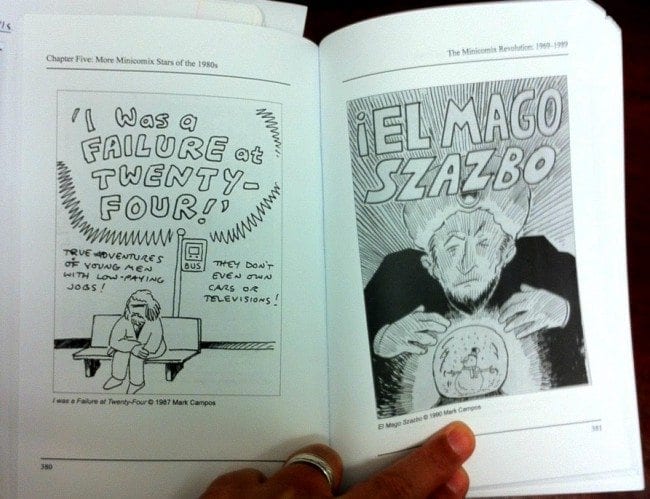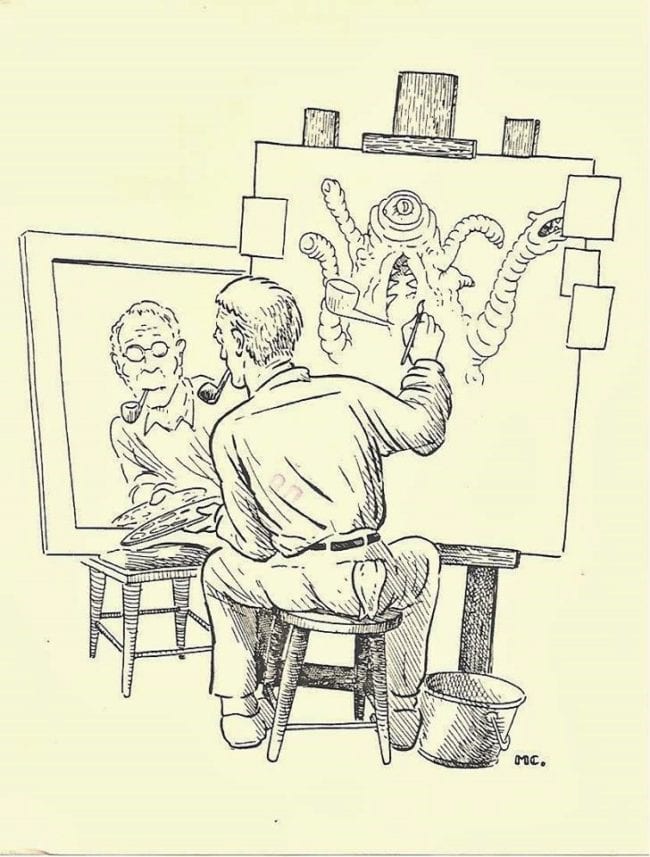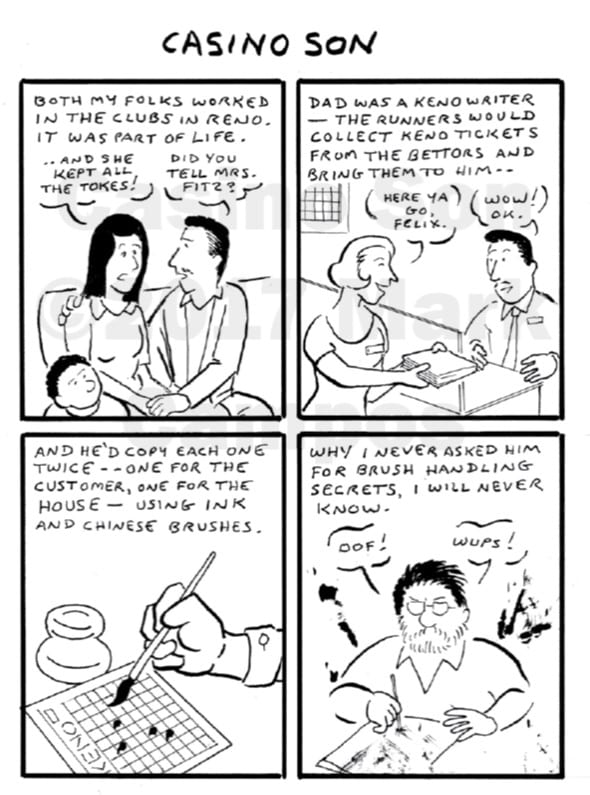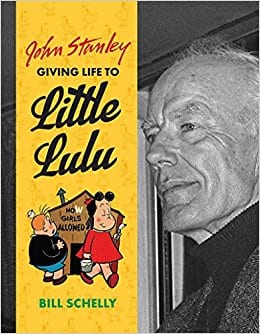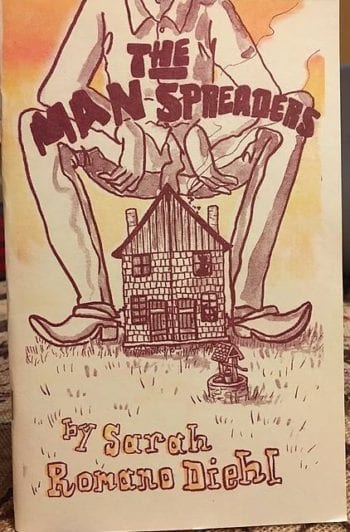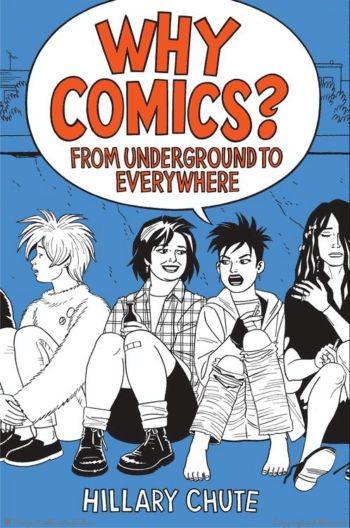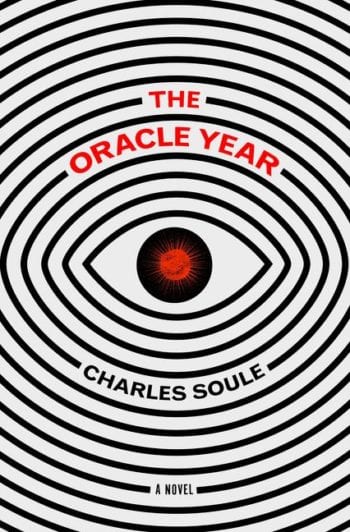At the top of my own stack of favorite books of 2017 sits a thick, five-pound book with about 800 old cartoons which are mostly political. Lest you think I have taken leave of my senses (which, of course, happened a long time ago), read on...
There’s an Art Young cartoon that makes me smile every time I think of it. First published in Life in 1925, it shows a wealthy man and woman yawning in unison with their pampered little fluff dog. The caption is, simply, “Ennui.” The visual itself is funny, perhaps even slightly screwball. It’s also a commentary on a hollow lifestyle, one dedicated solely to the attainment and preservation of wealth and material comforts – hence, the ennui. But it goes even deeper. The dog is the couple's pet, but they also could be seen as lapdogs of an unseen system. After the initial gag response at the humor, a curtain is pulled back a little to show something horrifying – a system built on exploitation. Yet, this cartoon goes deeper still. After laughing at the well-to-do folks (always satisfying), I then feel a pang of compassion for these people and their real-life counterparts. But, maybe I just think of this cartoon sometimes because the little dog on the pillow is funny, and no amount of analysis can explain why something is funny – it just is.
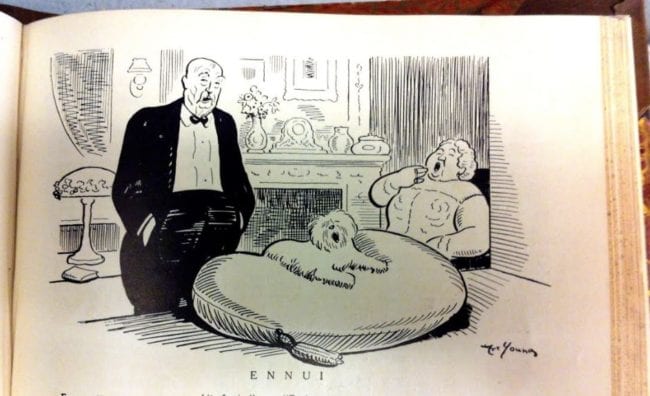
The multi-layered response an Art Young cartoon provokes, like the one above, moves cartoons away from consumable pop culture and more into the realm of art. How is it that this extraordinary, great cartoonist has faded from memory?
In the fall of 2017, Fantagraphics published To Laugh That We May Not Weep: The Life and Times of Art Young – a five-pound shot of love admirably capturing in its design the satisfying substance of Art Young’s work. At last, a handsome compendium of the brilliant work of Art Young, our most soulful cartoonist! These cartoons present history but speak to the ages, encompassing all our time on this earth as conscious, self-aware beings. Deeper and deeper, we go – to a bedrock of unshakable truth.

This is, after, all, work by a cartoonist who went to hell, artistically speaking, not just once, but three times! This is the guy who experienced what for many would be hell on earth, being put on trial for sedition (twice!) with the possibility of years of imprisonment. Undaunted, or perhaps just worn out from drawing his thousands of cartoons, Young famously dozed off in the courtroom during one of these trials. Whether or not you agree with Young’s politics, who could argue with the sad-beautiful reflections found in his gentle work? Art Young’s cartoons are some of the most complex, some of the richest, most original, most refined, most personal art I’ve ever experienced. To Laugh gives us the chance to have that experience. By presenting this work in a beautifully designed compilation, we can finally linger over it, take it in, and expand our understanding of what cartoons can do, and perhaps should do.
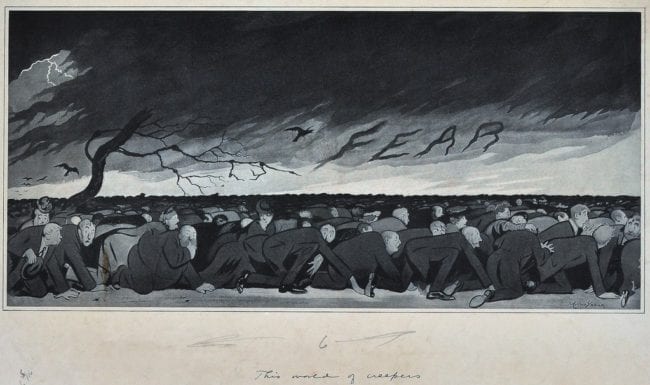
In 2017 America, we celebrate the remarkable new comics to emerge in the service of art. Here’s a cartoonist who went beyond that, to make art in the service of humanity. This, more than caricatures of tagged and labeled government officials, elephants and donkeys labeled, is true political cartooning. Art Young was political in the sense that everything is political. Paul Tillich once observed every human interaction is a power play – and in that fundamental truth Art Young’s work operates, with all the geniality, humor and eccentricity of a self-made, self-educated artist.
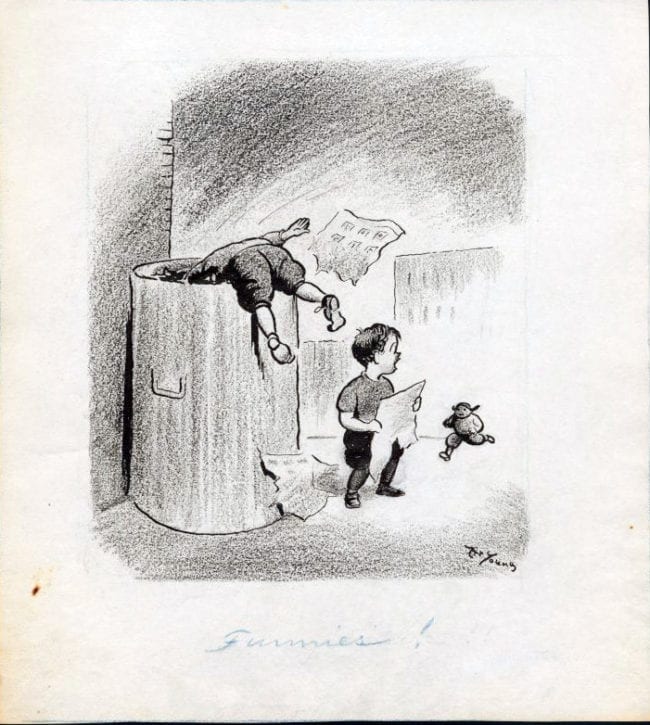
The centerpiece of To Laugh That We May Not Weep is a 24-page illustrated biographical essay by Eisner-award winning comics writer and historian Frank M. Young (no relation). Young, who also co-edited the book, contributes a typically well-researched piece. Essays by Young’s co-editor and the instigator of this fine book, Glenn Bray, political art collector Anthony J. Mourek, and comics legend Justin Green, among several others, illuminate various corners of Young’s life and work. Glenn Bray is, of course, one of the great collectors and curators of comics-related art. Among other books, he has authored The Harvey Kurtzman Index (1976) and The Original Art of Basil Wolverton (2015). A book devoted to his collection of comics art, The Blighted Eye, came out from Fantagraphics in 2016.
Art Spiegelman’s introduction to To Laugh (published in a slightly different form in The Atlantic) makes a good case for why we should care about Art Young: “While many of Art Young’s political cartoons were direct lessons on America’s rigged economic con game, all of his work was also a lesson in empathy. We have never needed more of both.”
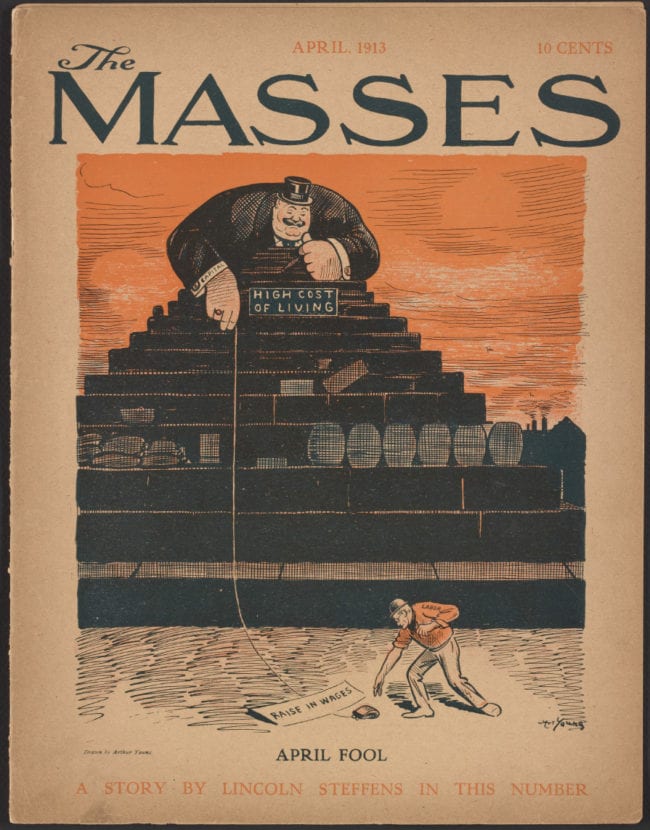

As a primer on Art Young, and a foundation for further work on this artist, this gorgeous book, so beautifully designed, falters ever so slightly – for me, at least. The problem lies, I think, at the root of the book’s impetus, which is to showcase images of the Art Young originals and rare items owned by Glenn Bray and other ardent collector-rescuers. This makes for an uneven presentation, perhaps only because Young was so prolific.
There is, for example, a good two-thirds of the contents of Young’s brilliant book, Trees At Night, presented (and no complaints about that, here!). However, the book offers only a small selection of work from his three Hell books, which comprise, Bray’s superbly written introductory text informs us, half of Young’s output of original illustrated books. We are informed another book, with more of Young’s Hell cartoons is in the works at Fantagraphics and Rosebud, with Jonathan Barli – but we are shortchanged in the inferno category in this grand volume, and that, for me, burns just a little. This aside, make no mistake: this is a gorgeous book, loaded with great cartoons and you must go out and buy it now. It may well stand as the most beautiful of the countless volumes Fantagraphics has thus far produced.

The book makes an admirable attempt to cover the span of Young’s life and work, hence the “Life and Times” subtitle. There are sections about Young’s work with the great socialist magazine The Masses and his own astonishing self-published cartoon magazine, Good Morning. Perhaps to lighten things up for the modern reader unused to such high stakes, truth-telling content, the book also contains sections on rather trivial divisions of Young’s work, including: Complexes, Fantasy and Musings, Quotation Cartoons, and Art Young on Art. Other sections resonate with Young’s major themes: Social Commentaries, On Religion, and Political Miscellaneous.
Being a bit OCD about comics history, I tip my hat to the heroic attempt made in To Laugh to catalog the eight hundred or so pieces presented, but some captions contain little or no publication information, or even a year. One can understand the near-impossible task of figuring out original publication dates on the basis of only having the original art. If this were required for To Laugh, we might be waiting years to see this volume!
However, in Young’s case, chronology and source is important, because he adjusted his work for different markets, softening his political approach sometimes. More importantly, at a certain point in his life, around the age of 40, Young decided to stop pandering to the markets and be his truest self in his work, a decision that doomed him to live frugally in his later years. This story, arguably one of the noblest moments I know of in American cartooning history, is a bit buried in the book due to the non-chronological presentation. No matter – organizing Young’s catalog (admittedly a huge task) is work that will be done by future comics scholars, I have no doubt.
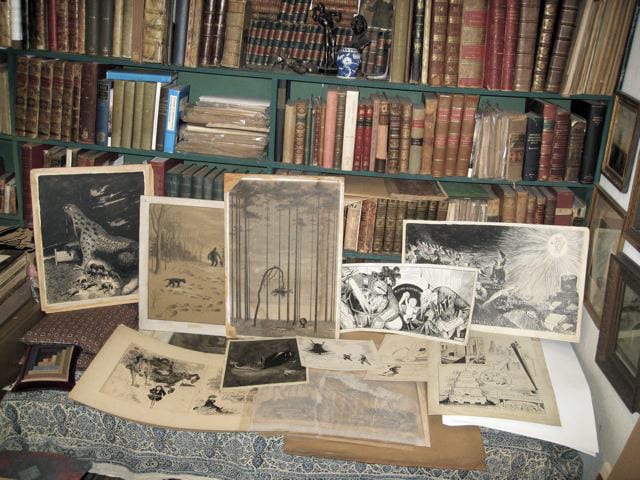

In the face of Art Young’s greatness and vital relevance to our own times, these flaws which may well only be something this critic sees, are minor – perhaps even unimportant. They cannot take away from the importance of this book to our times and to comics. It is a must-have book for any admirer and/or student of comic art, with its drop-dead stunning visual presentation adorned with several well-crafted essays. The sum total is to reveal Art Young as one of the True Greats and to offer a generous sampling from one of the sanest minds, one of the most warmly caring of all cartoonists. This was a guy who really did want to drain the swamp.

Here's nine more books I loved that came out in 2017:
2. Monograph by Chris Ware
This giant, complex book from Rizzoli could just as easily be called "Monolith." Printed on luxuriously thick paper with little surprise booklets hidden throughout, this book is mind-blowing. One doesn't read it as much as read at it. I spend morning coffee with this book, usually opening it at random and reading a page -- sometimes there are dense multi-panel comics, sometimes there's an essay by Ware, and sometimes there are photos of the toys, buildings and objects he has made. This is the best presentation of perhaps the greatest genius to work in comics -- go get it. I got my copy on December 25 and so I am still reading it. I can say with absolute certainty the curation is everything I could possibly want, and more. The text and art selections considerably deepen my understanding of Ware's life and career (so far). As for the rest of my comments -- well, maybe I'll tell you when I get over the thrill of just turning the pages and ogling one gorgeous design after another.
3. My Favorite Thing is Monsters by Emil Ferris
I already included this on my list of the best of 2016, because I was one of the lucky few to score an advance review copy. It didn't take brains to see this book would become a landmark, joining the shortlist of great "graphic novels." Ferris, who draws with a Goddess-like ability and tells fictional stories like she was really there and remembers every detail vividly, fulfills the promise of the long-form literary graphic story. I was lucky enough to be able to interview Emil Ferris for The Comics Journal earlier in 2017, where she said brilliant stuff like this: "Sometimes I like a word you read to be near an eye so that when you read that word you take in a ‘sense memory’ – if you will – of an eye. These things collide in the mind and the attempt is to heighten the evocation and resonance for the reader. This was something that the Surrealists taught and something I think I understood and wanted to emulate but it requires intuitive drawing to do that."
4. Complete Little Orphan Annie Volume 14: Sunshine and Shadow by Harold Gray
This series, designed by Dean Mullany at The Library of American Comics, and introduced by Jeet Heer is -- for me -- a miracle. The design is impeccable, incorporating pristine versions of the dailies and color Sundays in uniform, attractive volumes. There are few things more enthralling for me than reading a Harold Gray story (even when I disagree with his politics which are -- despite his last name, black and white), and this latest volume is a standout collection, with a continuity involving comic book censorship!
5. FUN: Spies, Puzzle Solvers, and a Century of Crosswords by Paolo Bacilieri
Ernie Bushmiller's first job on a newspaper was making crossword puzzles. Crossword puzzles and comics are related to each other, and Bacilieri delivers a messy (but FUN!) story exploring that connection within a classic Tintin-flavored mystery-adventure. The book contains stunning drawings of New York City at the time newspaper comics were born, when buildings looked sort of like vertical crossword puzzles, crosscut with equally mesmerizing images of modern-day Milan. Translated from Italian by Jamie Richards, this fine 300-page comic book seems to have mostly slipped under the radar in the U.S. of A. I advise you to go 12 Across and 7 Up to your nearest bookseller and seek it out.
6. John Stanley: Giving Life to Little Lulu by Bill Schelly
Schelly has, by virtues of passion and hard work, forged his skills as a writer and historian to reach new heights in comics-related biography and history books. His Harvey Kurtzman biography was beautifully researched and written -- creating the definitive book on an individual many (myself included) think was the greatest artist to work in comics in the 20th century. There's less source material available on the reclusive, modest John Stanley -- but Schelly has woven the sparse strands of what can be found out about this great artist into a compelling portrait. I also enjoy it when Schelly offers up some critical insight into the comics themselves. His paragraphs about Kubert's Hawkman stories in his biography of Joe Kubert, Man of Rock, were so good, I spent weeks hunting scans down to read them for myself. There's material like that here, too -- and it's good stuff. The monograph (still pretty long at I think around 50,000 words) is shorter than a full enchilada biography, but this gave the book designer room to breathe, and the result is a perfectly balanced combination of visuals and text.
7. The Man-Spreaders by Sarah Romano Diehl
Diehl is a Seattle artist who creates really enjoyable, highly original self-published comic books. Her work draws on the aesthetics of children's picture books, but her stories are oddball, wacky and enchanting -- sort of like the stories parents make up for their children at bedtime. This two-color riso printed book is a comedic western that -- as her recent work (including her strip in RESIST!) has done -- corrals male hubris and brands it with ass-kicking woman power but in a very funny, charming way. You might think of it as the Herstory of the West. Very much part of the #metoo movement, but also just a darned good comic, from the witty title to the last panel. Her comic, Wallenda, is on my 2015 best-of list. Available on Etsy.
8. Why Comics? From Underground to Everywhere by Hillary Chute
Chute is well respected in academic circles, and this book may well, one hopes, push her out to a much broader audience. She is the writer, above all others, Art Spiegelman has chosen to work with on projects such as MetaMaus. In Why Comics? Chute offers a way to get one version of a much-needed 50,000 foot understanding of modern comics by asking (and answering) ten thematic questions, such as: "Why Disaster?"and "Why Suburbs?" and "Why Punk?" I wish there was a fuller presentation of the history of comics before 1960 in this book, but I love her passion, ambition, and creativity. There are scores of new insights to be found in this why-se volume. It's no question at all: Why Comics? is a must-read, filling in a significant portion of the vast jigsaw puzzle of understanding comics.
9. The Oracle Year by Charles Soule
This one is actually a text-only novel that will be published by HarperCollins in April 2018, so I am cheating all the way around here. If it helps, I did read an advance review copy in 2017, and the author is known for his stories in comic books like Daredevil, She-Hulk, and Star Wars. He wrote the Death of Wolverine comic book, published in paperback in 2016. None of these comics interest me and I haven't read them. However, I was hooked by this novel from the first sentence. It's about an average Joe who receives in a dream a list of things that will happen in the near future. From sweeping changes to seemingly tiny and trivial incidents. I thoroughly enjoyed this book, which merges comic books and novels into something that feels a little bit new. It's not striving for much more than a fun ride, and that's just fine. There was a time when saying something was "comic-book like" would be a total diss -- but now, saying this could be a compliment, and so I happily say about this book: it reads like a comic book. It is fast-paced, visual, and tons of fun. Soon to be a hit and probably a Netflix flick, I predict -- and you can have that one from the Oracle for free.
10. Casino Son by Mark Campos
Mark Campos, another Seattle artist, is one of my favorite cartoonists. He emerged during the first wave of zine culture in the 1980s, creating clever, funny self-published comics that rank among the best offerings of this movement. Over the years, he has refined his visual storytelling into an accomplished minimalist style but has remained on the fringes by his own choice. He is also regarded as one of the best writers in the Seattle comics scene. A collection of his stories, Moxie, My Sweet is drawn by various other artists, including Eisner Award winner David Lasky.
For Casino Son, Campos set up a modest fundraising campaign, with the goal of publishing a new comic to premiere in person at the 2017 Latino Comics Expo, in Long Beach, California, November 11-12, 2017. The comic is a collection of short autobiographical vignettes which subtly reveal the conflicts of his Mexican-American upbringing with mainstream USA culture as represented by the casinos of Reno, Nevada -- where he grew up. Resonating with modern-day, Build The Wall America, Casino Son is a smartly underplayed commentary. Like the comics of Charles Schulz or Ernie Bushmiller, the stories in Casino Son are so well-crafted they read fast and offer depth. Great to see a new comic from Mark Campos -- I'm glad he rolled the dice on Casino Son.
1-19-18 update: It is with great sadness I must share the heartbreaking news Mark Campos took his own life yesterday. At this time, there are no further details. The above review was written in late December, 2017, weeks ago.
Mark Campos was a sensitive, brilliant, and complex person. It was my honor to spend a little time with him. One Thanksgiving he and David Lasky were at my house and we started drawing comics. I watched Mark draw and create fully realized characters and scenes out of thin air with the same sort of fascination I've watched skilled cartoonists like Charles Schultz draw in documentaries. His hand was sure, never hesitating, and his wit was keen. Mark Campos was the real deal.
In 2016, I wrote about Mark Campos in my essay "The Minicomix Revolution Will Not Be Televised." Here's that passage:
To this point, Mark Campos, a Seattle cartoonist and writer who has produced several notable minicomix since 1987 recently told me a story about teaching a class in the 1990s on how to make a minicomic. Afterwards, someone asked him: “how can I make money doing this?” As Campos told me this story, he looked as gently amused as a Buddhist teacher who had been asked how to make money from being kind to others.

